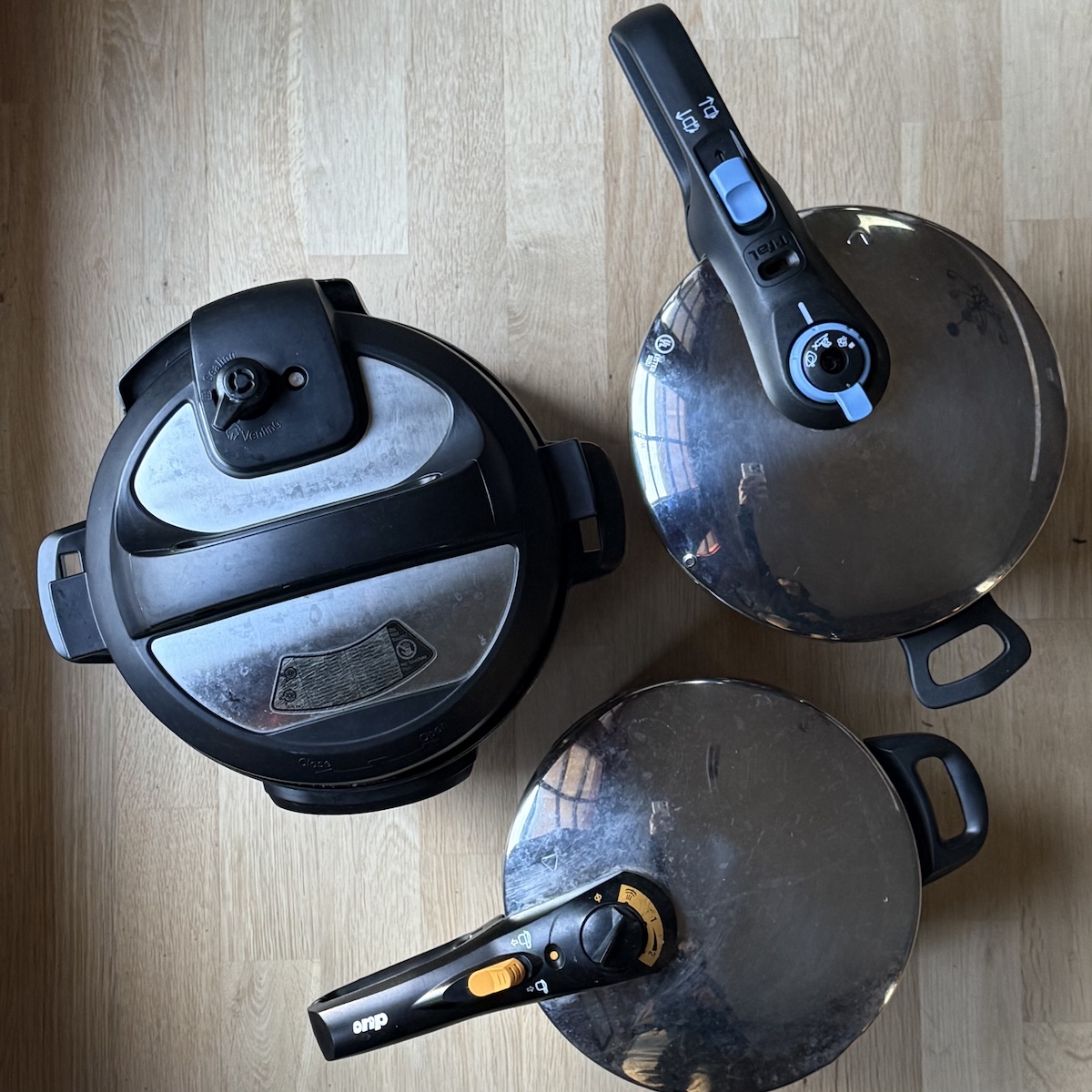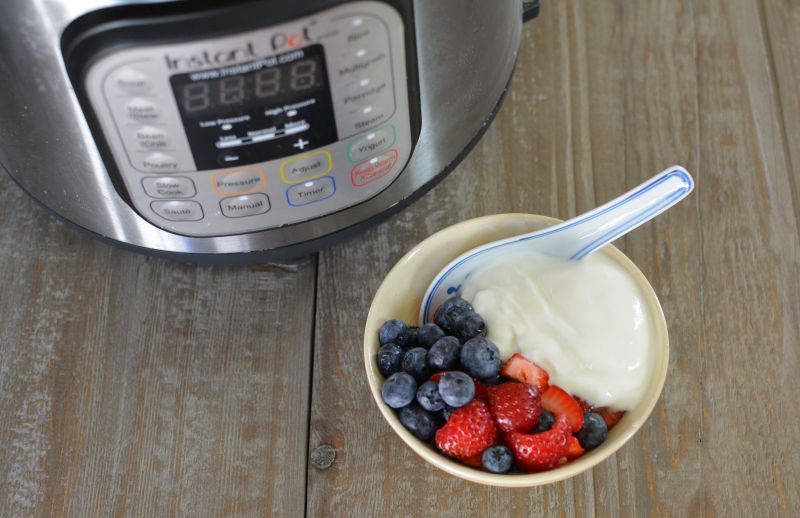My family had a pressure cooking pop its lid in the 1970s but that didn't stop me from using them in my kitchen. In fact, since around 2015, I have purchased and road tested over half a dozen pressure cookers for recipe development. They are wondrous time savers and come in a stovetop and electric models. Which one is for you? I hope to you help you make a good purchasing decision.

Pros and cons of pressure cookers
Having a pressure cooker in your arsenal of kitchen equipment gives you certain advantages but it has its limits. From my experiences over the years with using pressure cookers (PC or cooker), I've experienced these pros and cons:
(+) advantages of pressure cookers
- Dishes requiring long simmers (such as stews, beans, soups), can be prepared in less time in a pressure cooker
- Delicate ingredients like vegetables, eggs, and rice can be made very quickly
- It's easier to make relatively clear Asian noodle soup broth. For pho noodle soup broth, a pressure cooker yields a pretty clear broth because you never boil when you're pressure cooking so the dark bits of denatured proteins remain separate from the liquid. The fat separation is allows for you to dial in the richness level per your taste.
- Vegetable broths made in the pressure cooker has more flavor. The cooker does an amazing job with extracting flavor from vegetables.
- Seems to clean up very easily, likely because you never actively boil anything in it. Soaking and light scrubbing does the trick.
(-) disadvantages of pressure cookers
- You cannot easily monitor what is actually happening in the cooker because you cannot see inside the pot. Spontaneously lifting the lid is not possible (it's dangerous!). Given that, there's a risk of over cooking. (I've had many mushy pots of beans!)
- Each cooker has its peculiarities so you have to experiment and practice using it.
- Takes up space in your kitchen. But some cooks can make an entire dinner party in a pressure cooker.
How much time do you really save by pressure cooking?
They are not super time savers. Some cookers tout shaving off 50 to 70% of the time required for making a dish. Pressure cookers have to come to pressure and then release pressure. That takes time. Do the manufacturers add that in? I've wondered about how they come up with the time saving statistics.
In my experience, on average, I know I can save about 30 to 50% using a pressure cooker instead of a traditional pot on the stove.
Is an Instant Pot a pressure cooker?
Yes. It's just an electric pressure cooker. However, by design, the Instant Pot (IP) is categorically a "multicooker", which means it can function as a regular pot, slow cooker, and even yogurt maker. You can use it for sous vide. (I've not tried the Instant Pot that has the air-fryer function because I have my favorite air-fryer and that's enough!) The Instant Pot has amazingly taken over the multicooker space. There are other multicookers out there but Instant Pot dominates. IP established a cult-like following, and rose from the bankruptcy ashes to march forward. My Instant Pot below dates to 2017 or so. It outlasted a Fagor multicooker so it is a solid appliance.

Instant Pot vs stovetop pressure cookers
Pressure cooker brands that I have road tested include Instant Pot, Fagor (multicooker and pressure cookers), Zavor (the reincarnation of Fagor), T-fal and Presto. My experiences isn't exhaustive but it covers a fair amount of territory.
Why would you want a multicooker (essentially, an electric pressure cooker) over a stovetop pressure cooker? A multicooker like an Instant Pot allows you to:
- Set it and forget it. You don't have to watch the pot so long as you know how to press all the buttons to get the functions you want.
- Cook different ways (braise, steam, sous vide, air-fry, simmer) in one appliance.
Among the downsides to a multicooker is that it is bulky. Also, keeping it clean can be a pain in the butt. There are many parts to wash, wipe down and dry. If you over boil milk for yogurt, the clean up can be time consuming.
Releasing pressure naturally can take a long time in an Instant Pot; manually releasing pressure can be messy if you do not take precaution. I've had to wipe down my kitchen cupboards due to operator failure on my part. What I'm saying is that turning over too much cooking to a programmable machine can be problematic because you're relinquishing control.
All that said, I still have and use the basic Instant Pot 6-quart because sometimes I do want to set it and forget it. If I have a bunch of bones to cook the heck out of for stock, plugging in the IP makes sense. My husband makes yogurt in the IP every other week.
Stovetop Pressure Cooker Pros and Cons

Despite the cultish love of the Instant Pot, I adore stovetop pressure cookers. Above are ones by Fagor (left) and T-Fal (right). Why do I have stovetop ones? For these reasons:
- Stovetop pressure cookers weigh a lot less than Instant Pots.
- With few moving parts, stovetop pressure cookers are easy to maintain. They clean up well whereas the Instant Pot is easy to clean if you buy the add-on of a nonstick pot (ka-ching that's an extra expense!).
- Releasing pressure from a stovetop cooker is faster than it is for an Instant Pot. If you're in a hurry, you can carefully run water over the lid of a stovetop cooker to cool things down. You cannot do that with an Instant Pot. So, if you're cooking something and realized you made a mistake, you can undo it faster when using a stovetop cooker!
- Browning food for braises and stews is much much easier in a stovetop cooker because you are cooking on a stove burner, not relying on the heating element in a multicooker which is kinda weak.
- There are no buttons to push or programs to select with a stovetop model; it is very easy to operate.
The main disadvantage of the stovetop cooker is that it can only do one thing -- pressure cook! Also, you have to monitor and finesse the pressure, which can be a good or bad thing. You can walk away a stovetop cooker, but you must set a timer so you remember to check on it! There is steam being released as the cooker cooks so you hear it (the Instant Pot is quiet). But, I love the stovetop cookers because of the ease in using them. They're no-brainers.
Why I have two stovetop pressure cookers
They are of different capacities. The Fagor is a 6-quart pot (the size most people buy) and the T-Fal is an 8.5-quart pot (great for bigger batches of pho!). It may seem like the other way around because Fagor is wider. After my 8-quart cooker pooped out, I bought the T-Fal in 2024 and will tell you this: I LOVE IT.
Fagor no longer exists and its current reincarnation as Zavor doesn't produce products of the same quality. That's why I replaced by Zavor 8-quart with a T-Fal cooker with an awkward name -- Trendy. T-Fal Trendy is what the box said. It surprised me.

The Trendy by T-Fal's design heats up quickly, has low and high pressure settings, is not too noisy when whooshing, locks smoothly, and is easy to scrub clean. Moreover, for my recipe development needs, Trendy can function like 4 or 6-quart pressure cooker. That's all because of the skinny shape of the pot.
The Trendy is as wide as a 4-quart cooker but tall enough to handle 8.5-quarts. Given that, when I made a very small quantity of Vietnamese pork riblets in caramel sauce, the Trendy treated it as if it were a smaller pressure cooker. When you select a pot or pan for a dish, its shape and capacity impacts how ingredients cook. This photo shows how little of the pot was occupied. Trendy is flexible.

So, which pressure cooker should you buy?


Multi-function, Multicooker: The Instant Pot Duo 6-quart is solid and road tested in my kitchen for many years. If you want simplicity and durability, the Duo 7-in-1 Instant Pot has plenty of bells and whistles. I've never regretted owning one especially because there are so many IP cookbooks out there with failsafe recipes designed specifically for the machine. We also make yogurt in it and have more than enough money to get a new one but this one still works! Purchase the DUO at Amazon which also carries the RIO, a nifty anniversary edition.
Reliable, modern Pressure Cooker: Go with T-Fal Trendy. It has 2 pressure settings, which less priced models lack. Trendy will work on induction, regular electric, or gas stoves. I like Trendy so much that I bought one as a hostess gift. If you want a great performing, secure pressure cooker that does high and low pressure, T-Fal Trendy will do the job. Purchase at Amazon or Target. (T-Fal's site does not list Trendy though it does have the user manual).
PSI of Trendy vs Instant Pot
The are roughly the same: 7 PSI for low and 12 PSI for high. With the Trendy, you can manually adjust the heat on the pot to cook delicate items like vegetables on lower pressure to avoid over cooking them. The IP holds heat longer so it will seem like it's going great gang busters over the Trendy. But you have greater cooking control of a stovetop cooker. High pressure used to be 15 PSI but you'll be fine with 12 PSI.
Pressure Cooker and Instant Pot Recipes
The Instant Pot does not vent so you use less liquid to cook a dish. If needed, when translating an IP recipe for a stovetop cooker, use a little more water to compensate for the water lost via the steam vent; or, just add a little in after cooking.



















Leave a Reply